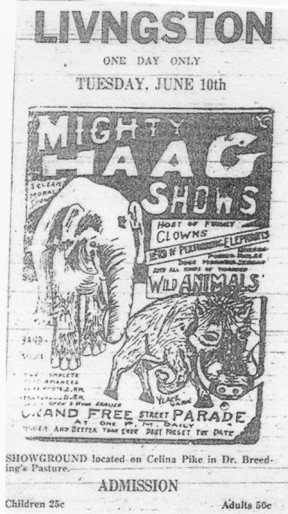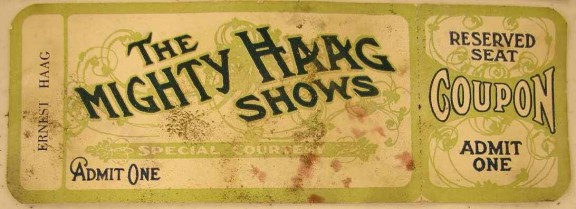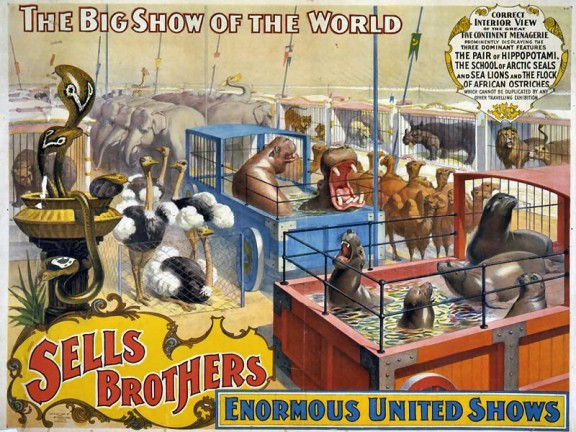|
Sells Brothers Circus
|
||

This ad appeared in the
Livingston Enterprise advertising the coming attraction of the Mighty
Haag Show.
|
One particular June 10th many years ago, the citizens of Livingston were invited to attend a circus that came to town via the Tennessee Central railroad in Algood. The name of the circus was the "Mighty Hagg Shows." A poster advertising the circus for the June 10 show gives the location as being on Celina Pike in Dr. Breeding's pasture. When the circus reached Algood by way of the train, the animals were unloaded there and then walked on to Livingston. The late Loyd White remembered the "Mighty Hagg Shows" setting up in Monroe, and from there, walking on to Byrdtown to perform. I read an article someone in Albany, Kentucky had written that tells about seeing the animals come parading into Albany to perform there and how excited everyone would be when they arrived. Information in the Robert and Mary Eldridge "History of Overton County, Tennessee" book tells how much excitement was created around Livingston in September, 1936, when a tiger escaped from its cage when a truck | |
| of the
Mighty Haag Circus had an accident at the Carr Creek bridge on Highway 42.
A large crowd soon gathered, many of them with guns, and the tiger was soon
driven into a cage and recaptured.
|
||
|
I did some research about that circus and learned that the owner was
a fellow by the name of Ernest Hagg who ran away from home at the age of
12 by hopping a box car in his hometown of Plymouth, Indiana. He ended
up in Philadelphia and then later in New York city living on his own. He
supported himself to begin with by shining shoes and selling newspapers.
He started what was first called "The Big Show" that began by using a
flatboat to travel along the Red River near Shreveport, Louisiana,
Later, the circus was unloaded and placed on a two-wheel cart drawn by
three mules. He eventually got a team of horses and an old farm wagon
that traveled as far as Kansas to perform. |
||
|
A ticket for the Mighty Haag Shows that came to Livingston in the 1930's.
|
||
| While
looking for information about the Mighty Haag Shows, I came across
something I thought would also be of interest, especially to the many
Sells’ families in this area. I have no idea if the people in this story
are connected to anyone in Overton County, but it would be interesting to
know. It seems that one of the largest tented amusement institutions
touring the United States in the 1880's and ‘90's was the Sells Brothers
Big Show of the World. Here is what I learned about what became the second
largest circus in America. Located near Columbus, Ohio, almost 1,000
acres was the unincorporated area called Sellsville. It was the winter
home for the internationally known Sells Brothers Circus, which later was
merged with the Ringling Bros. and Barnum & Bailey circus. Known for their
collection of elephants, the Sells Circus used railroad cars to transport
the assets, rather than wagons, and at their peak used 47 custom railroad
cars. History of the Sells Family tells how in the late 1700s, Ludwig
Sells, a German immigrant, sent his two sons to Ohio from their homestead
in Huntingdon County, Pa. to look for land to settle. Those sons poled a
flatboat up the Scioto River to what is now Dublin and, liking the lay of
the land there, brought their father and the rest of their family to
settle in 1801. One of Ludwig's grandsons, Peter, moved from Dublin to
Columbus in 1834 and found employment as a truck gardener and Methodist
lay preacher. He raised 11 children and was quite prosperous. Peter had
five sons, and all of them served in the American Civil War. One died in
Andersonville Prison, but the other four survived and were residents of
Columbus in the late 1860s. Three of them, Ephraim, Allen, and Lewis, were
in the auction business and followed circus troupes around the country in
order to take advantage of the audiences they attracted. After one failed
attempt at running their own circus show, they enlisted the help of their
brother Peter, the youngest member of the family, then employed as a
reporter for the Ohio State Journal. The brothers became fascinated by a
man named "Cannonball George Richards," a performer who billed himself as
a "percussive aerialist." He shot himself out of a cannon on a daily
basis. In 1871, after adding Peter to the Sells team, the brothers
purchased George Richards' act, some cast-off circus equipment, nine cages
of animals, and two camels for $6,500. The first show was presented in
downtown Columbus at State and High Streets in the spring of 1871. It
consisted of the small menagerie, Cannonball George Richards, a few side-
show acts and some horseback riding acts. Peter traveled ahead of the performers to establish contracts and
routing, post advertisements and secure railroad reservations. The circus
occasionally visited Maryland and some areas of the Mid-Atlantic states,
but rarely ventured into New England, which was then the territory of the
Barnum and Forepaugh shows. Their circus eventually traveled westward,
profitably competing with other shows and even visiting Australia in 1891.
That year the company logged over 40,000 miles on the road. At its height,
the show was transported from town to town in three sections with a total
of 47 special railroad cars carrying it. The outfit included a 328-foot
big top, six other large tents, 322 workers, 64 performers, 50 cages of
wild animals, 13 elephants, and 7 camels. Peter Sells married Mary (Luker) in Canton, Missouri in 1878, and shortly afterward the couple moved to Columbus, where the circus was headquartered. The Sells family owned several properties near downtown Columbus, particularly the near north side, and the couple resided in various homes until 1895 when the mansion was built. The home was designed by Frank Packard and was located at the edge of Goodale Park on Dennison Avenue. Mary Sells didn't enjoy circus life and did not often accompany her husband in his travels. It is believed that the mansion was built partly to accommodate the Sells' young daughter Florence, born in the late 1880's, and partly to appease the discontented Mary. The family's stay at the mansion wasn't a long or a particularly happy one. In late November of 1899, Peter Sells moved out of the house and shortly thereafter filed for divorce from his wife, due to Mary's alleged adulterous activity with two men, one of whom was an associate of Peter's. The stories surrounding the divorce and divorce trial proceedings kept Columbusites at the edge of their seats for over a year. During the trial, much of the testimony centered around the Sells mansion, where Mary and Florence lived while Peter was traveling. Mary continued to reside in the house during the trial, but in early 1901, Peter Sells regained possession of his home and reestablished residence there with his daughter Florence. He and Florence were estranged from his wife for over a year before the divorce was made final. Shortly after the divorce was granted, Peter sold the house.
|
||
|
A poster from the 1800'sadvertises the Sells Brothers Circus.
|
||
| The
Sells home cost $40,000 to build, an enormous sum for the year 1895. The
Romanesque style was popular during the latter part of the 19th Century,
but the exterior of the Sells mansion is exceptional because it is crowned
with a bell cast hipped tile roof, reminiscent of Spanish-Moorish
architecture. The carriage house shares the same hard-fired brick and
other exterior features as the main house, including Moorish arched
windows and doors, and the same tile roof. The dramatic flared roof lines
of both buildings evoke images of the circus big top; their Moorish
influences and tile roof may have been a result of Peter and Mary Sells'
trip to California in 1891, where the same styles and materials were and
are common. Since 1895, the home has been occupied by several owners and
has undergone numerous architectural changes, many of which have created a
more institutional look to the once grand interior. The current owners,
David and Erica Brownstein, bought the home in 1997 and are attempting to
restore some of the home's original grandeur. The strong family bonds that kept the circus going were weakened by the death of Ephraim, the eldest brother, in 1898. After Ephraim's death, James Bailey of Barnum and Bailey and W.W. Cole, of Cole Brothers Circus, each acquired a quarter interest in the business. When Peter, aged 59, and Allen both passed away in 1904, and with no family members interested in carrying on the family business, Lewis Sells sold the remaining shares of the show to Bailey for $150,000 cash in 1905. Bailey then sold half share of the Sells circus to the Ringling Brothers, whom the Sells brothers had contemptuously dubbed "the Ding Dong brothers." In 1906, Bailey died and the Ringlings bought the entire circus. They sent the Sells outfit on tour in 1907, 1910 and 1911, the last years that the circus toured under the name Sells Brothers. The Columbus head-quarters was closed by 1910. The act eventually became part of the conglomerate Ringling Brothers, Barnum and Bailey's Greatest Show on Earth.
|
||

